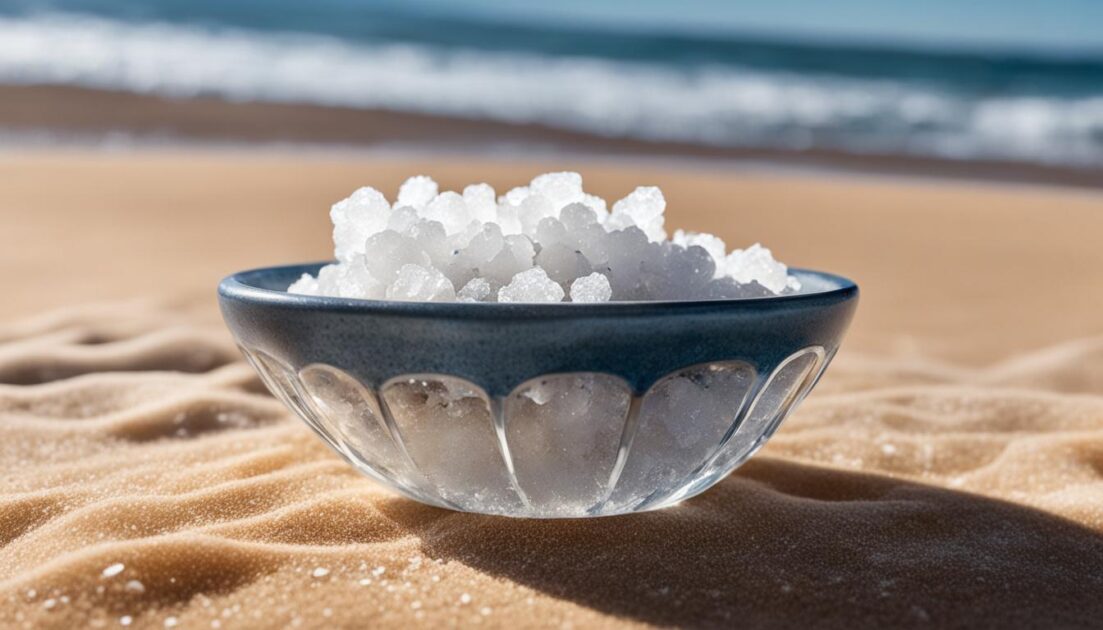Sea salt, a natural alternative to table salt, has gained popularity for its perceived health benefits. But what exactly are these benefits and how does sea salt compare to traditional table salt?
Sea salt is made through the process of evaporating salt water, leaving behind minerals and trace elements that are believed to contribute to its health advantages. While it is commonly used in cooking, sea salt has also found its way into various beauty and wellness products.
One of the main selling points of sea salt is its natural composition. Unlike table salt, which undergoes heavy processing and has additives like iodine, sea salt is less refined and retains trace minerals like potassium, iron, and calcium. These minerals are often touted as important for overall health and well-being.
Key Takeaways:
- Sea salt is a natural alternative to traditional table salt.
- It retains minerals and trace elements that are believed to have health benefits.
- Sea salt is used in both cooking and beauty products.
- It contains potassium, iron, and calcium.
- Scientific research on the actual health benefits of sea salt is limited.
Sea Salt vs. Table Salt
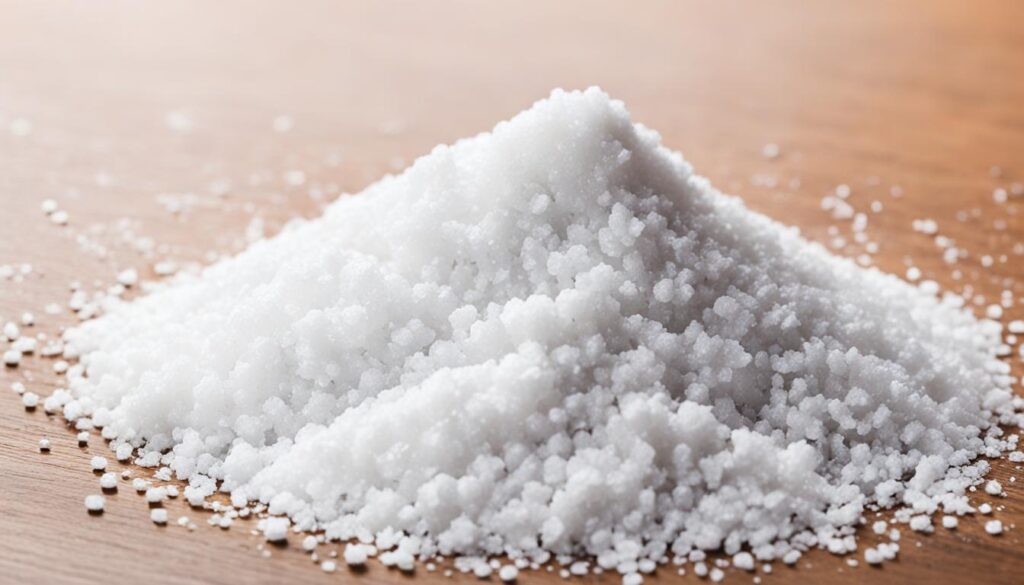
When it comes to choosing between sea salt and table salt, there are some key differences to consider. Sea salt is less processed and contains trace minerals, while table salt is heavily ground and stripped of most of its nutrients. However, it’s important to note that the trace minerals found in sea salt are only present in small amounts, so you would need to consume large quantities to truly benefit from them.
Both sea salt and table salt contain sodium, which is an essential mineral needed by the body. However, excessive sodium intake can lead to health problems such as high blood pressure and heart disease. It’s important to consume salt in moderation and be mindful of your sodium intake.
Here’s a quick breakdown of the main differences between sea salt and table salt:
| Sea Salt | Table Salt |
|---|---|
| Less processed | Heavily ground and refined |
| Contains trace minerals | Most nutrients removed |
| Mineral content varies | Uniform mineral content |
While sea salt may offer some trace minerals and a less refined option, it’s important to note that these differences are minimal in terms of overall nutrition. Regardless of the type of salt you choose, moderation is key.
Potential Benefits of Sea Salt
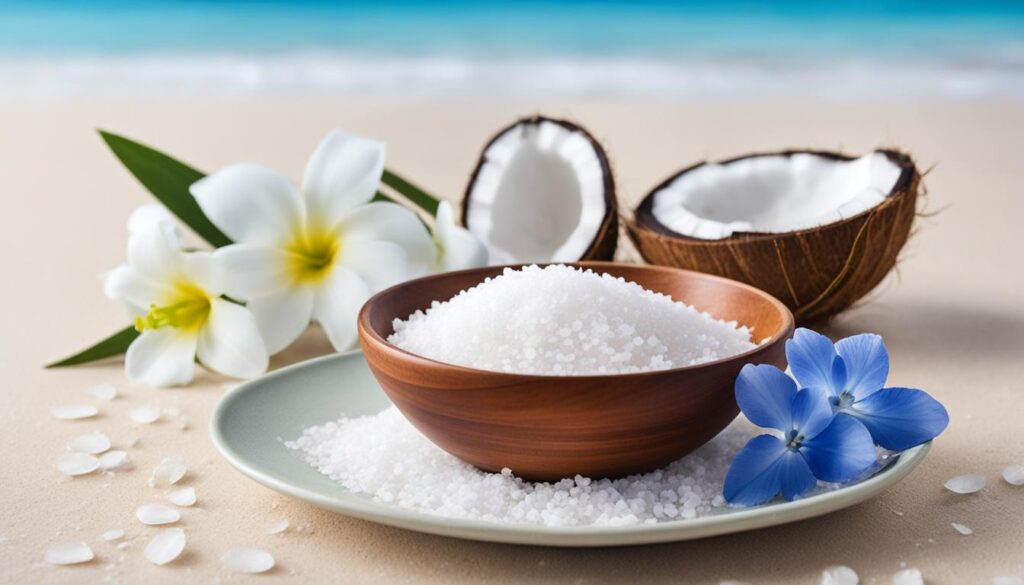
Sea salt is not just a flavorful addition to your meals; some people believe it offers a range of benefits beyond its taste. While scientific research is limited, here are some potential reasons why sea salt has gained popularity for more than just its culinary uses.
Maintains Hydration and Healthy Blood Pressure Levels
Sea salt contains minerals like potassium, which is known to help maintain hydration levels in the body. Adequate hydration is essential for overall health and plays a crucial role in various bodily functions, including digestion and circulation. Additionally, sea salt is believed to promote healthy blood pressure levels. The minerals found in sea salt, such as potassium and magnesium, may support cardiovascular health and help regulate blood pressure within a normal range.
Aids in Digestion
Sea salt has been thought to have digestive benefits. It is believed to stimulate the production of digestive enzymes, which can help break down food and aid in smoother digestion. The minerals in sea salt may also assist in the absorption of nutrients and contribute to a healthy digestive system.
Improves Skin Health
Sea salt has gained popularity in the world of skincare due to its potential benefits for the skin. It is often used in exfoliating scrubs, body washes, and bath salts to help improve skin health. Sea salt’s exfoliating properties can help remove dead skin cells, leaving the skin feeling refreshed and rejuvenated. Additionally, sea salt may help reduce dryness and inflammation, making it a potential natural remedy for certain skin conditions like eczema.
Potential Benefits of Sea Salt
| Benefit | Description |
|---|---|
| Maintains hydration | Sea salt contains minerals that may help with hydration. |
| Supports healthy blood pressure levels | The minerals in sea salt, such as potassium and magnesium, may contribute to maintaining healthy blood pressure levels. |
| Aids digestion | Sea salt is believed to stimulate digestive enzymes and promote smoother digestion. |
| Improves skin health | Sea salt’s exfoliating properties and potential anti-inflammatory effects may help improve skin health and reduce dryness and inflammation. |
While these claims exist, it is essential to note that scientific research on the benefits of sea salt is limited, and individual results may vary. Consult with a healthcare professional or dermatologist if you have specific concerns or conditions related to your skin or overall health.
Downsides of Too Much Salt
While sea salt can add flavor to foods and have some non-dietary uses, consuming too much salt, including sea salt, can be detrimental to health. High sodium intake is associated with high blood pressure, osteoporosis, and other health issues. People with kidney disease, high blood pressure, and heart failure should be cautious about their salt intake, including sea salt. It is important to use sea salt or any other salt in moderation.
Excessive salt consumption, especially from sea salt, can have negative effects on the body. The minerals found in sea salt, although in small amounts, can contribute to these health risks if consumed in excess. High sodium intake can lead to hypertension, a condition associated with an increased risk of heart disease and stroke.
Health Risks of Excessive Sodium Intake
- High blood pressure: Consuming too much sodium can raise blood pressure levels, putting strain on the heart and blood vessels.
- Osteoporosis: Excessive sodium can increase calcium excretion, potentially leading to a decrease in bone density over time.
- Kidney damage: A high-sodium diet can strain the kidneys, leading to kidney disease or worsening existing kidney conditions.
- Fluid retention: Excess sodium can cause the body to retain water, leading to bloating and swelling.
Individuals with preexisting health conditions, such as kidney disease, high blood pressure, and heart failure, should be especially cautious about their salt intake, including sea salt. Consulting with a healthcare professional can provide personalized recommendations about salt consumption and help manage these conditions effectively.
It is crucial to be mindful of the amount of salt consumed and to use sea salt or any other type of salt in moderation. A balanced diet that includes a variety of nutrient-rich foods is essential for maintaining good health.
| Health Risks | Impact |
|---|---|
| High blood pressure | Increased risk of heart disease and stroke |
| Osteoporosis | Potential decrease in bone density |
| Kidney damage | Worsening of existing kidney conditions |
| Fluid retention | Bloating and swelling |
It is important to prioritize overall well-being and make informed choices about salt intake, including sea salt. Using sea salt or any other salt in moderation can help maintain a balanced diet and reduce potential health risks associated with excessive sodium consumption.
How to Use Sea Salt
Sea salt is a versatile ingredient that can be used in a variety of dishes and preparations. Here are some ways to incorporate sea salt into your cooking:
1. Seasoning:
Sea salt can be used as a substitute for table salt when seasoning your dishes. Due to its larger granules, you may need to use slightly more sea salt to achieve the desired flavor. Sprinkle sea salt on roasted vegetables, grilled meats, or pan-seared fish to enhance their natural flavors.
2. Baking:
Sea salt can also be used in baking to add a hint of saltiness and enhance the overall taste of your baked goods. Whether you’re making cookies, cakes, or bread, replace table salt with sea salt in your recipes. Just keep in mind the difference in granule size and adjust accordingly.
3. Desserts:
Sea salt can provide a unique flavor profile to desserts, especially when combined with sweet ingredients. Sprinkle a pinch of sea salt on top of caramel or chocolate-based desserts, such as brownies or salted caramel ice cream, to create a delightful contrast of flavors.
4. Salt Baths:
In addition to culinary uses, sea salt can also be used for skin care. Create a luxurious and relaxing sea salt bath by dissolving a handful of sea salt in warm water. Soak in the bath for 20 minutes to help soothe tired muscles and exfoliate your skin.
| Benefits of Using Sea Salt for Cooking |
|---|
| Enhances the natural flavors of dishes |
| Adds a touch of saltiness to baked goods |
| Creates a delightful contrast in sweet desserts |
| Soothes tired muscles and exfoliates the skin in salt baths |
Remember, while using sea salt in your cooking can provide some unique flavors and potential health benefits, moderation is key. It’s important to balance your salt intake with a well-rounded diet and consult with a healthcare professional for personalized advice.
The Bottom Line

When it comes to sea salt, there are many claims about its natural benefits and potential health advantages. However, it is important to understand that sea salt should not be considered a miracle remedy and the purported benefits are not strongly backed by scientific research. While sea salt does contain trace minerals and may add flavor to your meals, it should be used in moderation, just like any other type of salt.
Excessive sodium intake can have negative effects on health, including high blood pressure and an increased risk of heart disease. Therefore, it is crucial to stay mindful of your overall sodium consumption and not exceed the recommended daily intake. If you have specific health conditions or concerns, it is always best to consult with a healthcare professional.
Using Sea Salt Responsibly
Sea salt can be a part of a balanced diet and can enhance the taste of your favorite dishes. However, it should be used sparingly and in combination with a variety of other flavorful ingredients. Remember that the sodium in sea salt, as well as any other type of salt, adds up quickly, so be mindful of your daily intake.
Consider incorporating other herbs and spices into your cooking to reduce your reliance on salt for flavor. Experiment with using less salt and gradually reducing your intake to develop a taste for foods that are naturally flavorful without excessive salt. By making small adjustments to your cooking habits, you can continue to enjoy the taste of your meals while promoting your overall health.
“Sea salt provides a unique taste and texture to dishes, and some people enjoy its subtle variations compared to table salt. However, it is important to remember that sea salt is not a magic ingredient that will transform your health overnight. Moderation and balance are key when it comes to incorporating sea salt into your diet.” – Dr. Sarah Thompson, Nutrition Expert
| Benefits of Sea Salt | Drawbacks of Sea Salt |
|---|---|
|
|
Remember, the best way to maintain good health is to follow a well-rounded diet that includes a variety of nutrient-rich foods. While sea salt can be a part of your culinary repertoire, it should not be relied upon as a sole source of health benefits. Balance, moderation, and consultation with a healthcare professional are always key to making informed choices for your well-being.
Celtic Sea Salt: A Natural Alternative

Celtic sea salt, also known as sel gris or grey salt, is a less refined and more natural alternative to table salt. Harvested from the coastal stretches of France, Celtic sea salt offers a range of potential health benefits due to its unique composition of trace minerals and elements.
Unlike heavily processed table salt, Celtic sea salt retains more of its natural minerals, making it a popular choice among health-conscious individuals. These minerals include potassium, magnesium, and calcium, which play essential roles in maintaining various bodily functions.
One of the potential benefits of Celtic sea salt is its ability to help balance electrolytes in the body. Electrolytes are essential for proper nerve function, muscle movement, and fluid balance. By incorporating Celtic sea salt into your diet, you may support optimal electrolyte levels.
Another advantage of Celtic sea salt is its potential to improve digestion. The minerals and trace elements in Celtic sea salt can aid in the breakdown and absorption of nutrients, promoting a healthy digestive system.
While Celtic sea salt offers potential health benefits, it’s important to note that individual results may vary. Consulting with a healthcare professional before adding Celtic sea salt to your diet is recommended, especially if you have specific health conditions or concerns.
In summary, Celtic sea salt provides a natural alternative to table salt and has the potential to offer various health benefits. However, it’s crucial to use Celtic sea salt in moderation and consider your individual dietary needs. Consulting with a healthcare professional can help ensure that incorporating Celtic sea salt into your diet aligns with your overall health goals.
| Benefits of Celtic Sea Salt | Usage |
|---|---|
| Electrolyte balance | Use as a seasoning in cooking or as a finishing salt |
| Improved digestion | Add to meals to enhance flavor and nutrient absorption |
| Soothing properties for skincare | Can be used in homemade scrubs or bath salts |
Different Types of Salts

When it comes to choosing salt, there are various options available, each with its own unique characteristics. Let’s explore some of the different types of salts and understand how they differ from one another.
Celtic Sea Salt
Celtic sea salt is a less refined and more natural alternative to table salt. It is harvested from the coastal stretches of France and contains trace minerals and elements that may support various bodily functions.
Table Salt
Table salt is the most common type of salt found in kitchens. It is heavily processed and typically contains added iodine to prevent iodine deficiency. Table salt has a fine texture and dissolves easily.
Himalayan Pink Salt
Himalayan pink salt is gathered from ocean beds and has a unique pink color due to the presence of trace minerals like iron. It is less refined compared to table salt and adds a subtle flavor to dishes.
Dead Sea Salt
Dead Sea salt is known for its therapeutic properties and is mainly used in skincare products. It is rich in minerals like magnesium, calcium, and potassium, which can help nourish the skin.
Kosher Salt
Kosher salt is a coarse salt commonly used in kosher meat preparation. It is called “kosher” because it follows specific Jewish dietary guidelines. Kosher salt is free from additives and has a large, irregular grain size.
| Salt Type | Source | Texture | Trace Minerals |
|---|---|---|---|
| Celtic Sea Salt | Coastal stretches of France | Coarse | Contains trace minerals and elements |
| Table Salt | Mined and processed | Fine | Usually fortified with iodine |
| Himalayan Pink Salt | Ocean beds | Coarse | Contains trace minerals like iron |
| Dead Sea Salt | Dead Sea | Coarse | Rich in minerals like magnesium and calcium |
| Kosher Salt | N/A | Coarse | Minimal processing and no additives |
Choosing the right type of salt depends on your personal preferences and dietary needs. Celtic sea salt is less refined and contains more trace minerals, while table salt is commonly used and fortified with iodine. Himalayan pink salt adds a unique flavor, Dead Sea salt has skincare benefits, and kosher salt is ideal for kosher meat preparation. Consider your taste preferences and health requirements when selecting the type of salt for your meals.
Advantages of Celtic Sea Salt
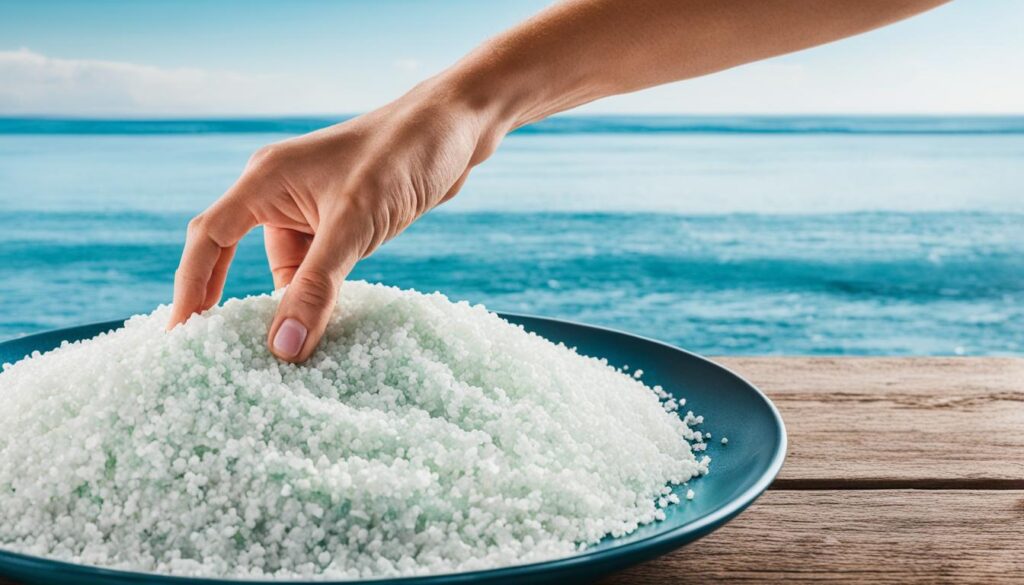
In addition to its unique composition and natural sourcing, Celtic sea salt offers several key benefits for overall health and well-being.
- Electrolyte Balance: Celtic sea salt is rich in essential electrolytes such as sodium, potassium, and magnesium. These electrolytes play a crucial role in maintaining fluid balance, supporting nerve function, and facilitating proper muscle movement.
- Improved Digestion: The trace minerals found in Celtic sea salt can aid in digestion by promoting the secretion of digestive enzymes and supporting the breakdown of food. This can contribute to better nutrient absorption and overall digestive health.
- Alkalizing Properties: Celtic sea salt has alkalizing properties, which means it can help balance the body’s pH levels. Maintaining a healthy pH balance is important for optimal cellular function and overall well-being.
- Immune Support: The trace minerals present in Celtic sea salt, such as zinc and selenium, contribute to a strong immune system. These minerals play a vital role in supporting immune function and promoting overall wellness.
Celtic sea salt can also be beneficial for external use. It has mild detoxifying effects and can be used in skincare for its soothing properties. However, it’s important to use Celtic sea salt in moderation and consider individual dietary needs.
Drawbacks of Celtic Sea Salt
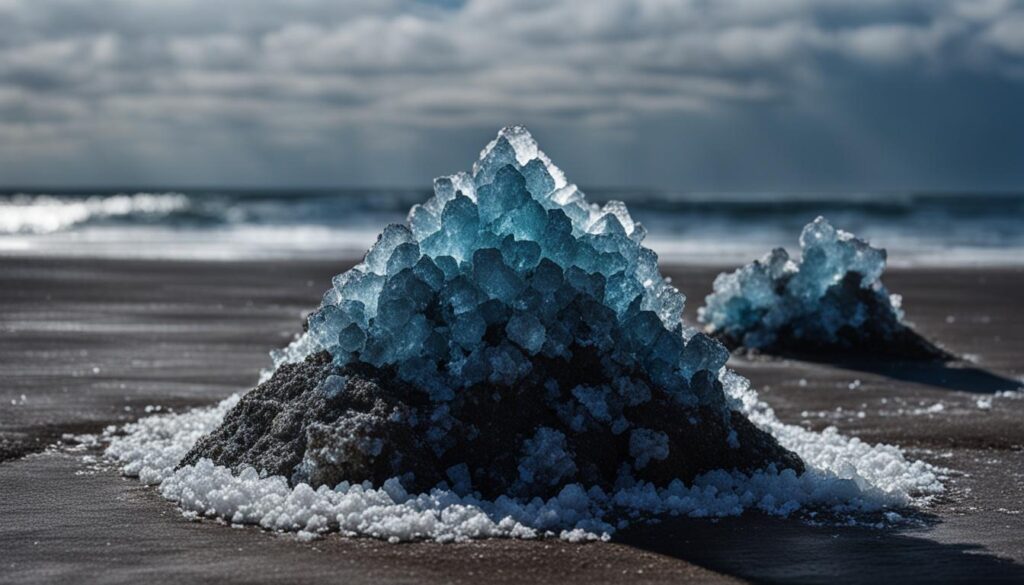
While Celtic sea salt offers potential health benefits, it is important to be aware of its drawbacks. Here are three key considerations:
Sodium Content
One drawback of Celtic sea salt is its sodium content. While sodium is an essential mineral, excessive intake can be harmful, particularly for individuals with high blood pressure or at risk of heart disease. It is crucial to monitor sodium intake and take into account the sodium content of Celtic sea salt when incorporating it into your diet.
Lack of Iodine
Another drawback of Celtic sea salt is its lack of iodine. Iodine is a vital nutrient for thyroid function and overall health. Individuals who rely solely on Celtic sea salt as their primary source of salt may be at risk of iodine deficiency. It is important to ensure you are getting adequate iodine from other sources, such as iodized salt or foods naturally rich in iodine.
Heavy Metal Contamination
There have been concerns about heavy metal contamination in sea salts, including Celtic sea salt. Due to factors such as pollution and environmental factors, sea salts can potentially contain trace amounts of heavy metals. To mitigate this risk, it is crucial to choose Celtic sea salt from reputable sources that conduct rigorous testing for heavy metals and other contaminants.
It is essential to consider these drawbacks and make informed choices about the use of Celtic sea salt in your diet and lifestyle.
| Drawback | Explanation |
|---|---|
| Sodium Content | Excessive sodium intake can pose health risks, particularly for individuals with high blood pressure or at risk of heart disease. |
| Lack of Iodine | Celtic sea salt does not contain iodine, an essential nutrient for thyroid function. Additional sources of iodine must be included in the diet. |
| Heavy Metal Contamination | There have been concerns about heavy metal contamination in sea salts, including Celtic sea salt. It is important to choose reputable sources that test for heavy metals and other contaminants. |
How to Use Celtic Sea Salt
When it comes to incorporating Celtic sea salt into your diet, it’s important to consider the recommended sodium intake for optimal health. For healthy adults, the daily sodium limit is approximately 2,300 mg, which is equivalent to about 1 teaspoon of Celtic sea salt. However, it’s important to note that individual sodium needs may vary based on factors like age, sex, activity level, and overall health. Consulting with a healthcare professional can help determine the appropriate amount of Celtic sea salt for your specific needs.
Celtic sea salt can be used in various ways to enhance the flavor of your dishes. Whether you’re cooking, baking, or simply seasoning your meals, Celtic sea salt can add a delicious touch to your culinary creations. Its natural and slightly coarse texture provides a unique crunch and taste. Additionally, Celtic sea salt can be used as a finishing salt, sprinkling it lightly over your dishes just before serving to enhance the flavors and add a decorative touch.
Aside from its culinary uses, Celtic sea salt can also be added to water for potential hydration benefits. This is because Celtic sea salt contains essential electrolytes like sodium, potassium, and magnesium, which help maintain fluid balance in the body. However, it’s important to note that maintaining a balanced diet with other electrolyte-rich foods is crucial for overall hydration.
In summary, Celtic sea salt is a versatile ingredient that can be used in various ways in the kitchen. Whether you’re looking to add flavor to your dishes or reap potential hydration benefits, Celtic sea salt offers a natural and mineral-rich alternative. Remember to use it in moderation and consider consulting with a healthcare professional for personalized dietary recommendations.
Choosing the Right Salt
When it comes to selecting the right salt for your culinary adventures, the choice often boils down to personal preference. Sea salt and table salt are two popular options, each with its own unique characteristics. Sea salt is renowned for its natural source and additional minerals, such as potassium, iron, and calcium. On the other hand, table salt is typically fortified with iodine and may have a finer texture.
While sea salt and table salt differ in terms of their origins and properties, it’s essential to remember that both types contain the same amount of sodium. Therefore, moderation is key when incorporating them into your diet. Additionally, for those seeking alternatives, other types of salt like Celtic sea salt, Himalayan pink salt, and kosher salt offer distinct flavors and qualities that may suit your specific needs and taste preferences.
Ultimately, the decision of choosing the right salt rests in your hands. Whether you opt for sea salt, table salt, or explore other options, it’s important to use salt sparingly and be mindful of your sodium intake. So, go ahead and savor the flavors, knowing that you’ve made a choice that aligns with your culinary aspirations.
FAQ
What are the benefits of using sea salt?
Sea salt is believed to have some potential benefits, such as maintaining hydration, aiding digestion, and promoting skin health. However, more research is needed to fully understand these claims.
How does sea salt differ from table salt?
Sea salt is less processed and contains trace minerals, while table salt is heavily ground and has most of its nutrients removed. However, both types of salt contain sodium, so it’s important to use them in moderation.
Can sea salt be used for skin care and hair care?
Yes, sea salt is commonly used in body scrubs and baths for exfoliation and relaxation. It can also be beneficial for skin conditions like eczema. Additionally, sea salt can add texture and volume to hair when used in hair sprays or sea salt sprays.
Are there any downsides to consuming too much salt?
Excessive sodium intake, including sea salt, can lead to high blood pressure, heart disease, and other health issues. Individuals with kidney disease, high blood pressure, and heart failure should be cautious about their salt intake.
How can sea salt be used in cooking?
Sea salt can be used as a substitute for table salt in most dishes. It can be sprinkled on roasted vegetables, added to desserts, and used to season meats and fish.
What should I consider when choosing the right salt?
The choice between sea salt and table salt ultimately comes down to personal preference. It’s important to use salt in moderation and consider other factors like iodine content and texture.
What is Celtic sea salt and what are its benefits?
Celtic sea salt is a less refined and more natural alternative to table salt. It contains trace minerals and electrolytes that may support various bodily functions, such as fluid balance, digestion, and immunity.
How does Celtic sea salt differ from other types of salt?
Celtic sea salt differs from table salt, Himalayan pink salt, and Dead Sea salt in terms of composition and sourcing. It is less refined and contains more trace minerals. Himalayan pink salt is gathered from ocean beds and has a distinct pink color, while Dead Sea salt is mainly used in skincare products.
What are the drawbacks of using Celtic sea salt?
Celtic sea salt still contains sodium, which can be harmful in excess, especially for individuals with high blood pressure or at risk of heart disease. It also lacks iodine, an essential nutrient for thyroid function, so alternative sources should be considered. There have also been concerns about heavy metal contamination in sea salts, including Celtic sea salt.
How can Celtic sea salt be used?
Celtic sea salt can be used in cooking, baking, or as a finishing salt to enhance the flavor of dishes. It can also be added to water for potential hydration benefits. However, it’s important to maintain a balanced diet with other electrolyte-rich foods.
How much Celtic sea salt should I consume?
The recommended daily sodium intake for healthy adults is about 2,300 mg, equivalent to approximately 1 teaspoon of Celtic sea salt. Individual sodium needs may vary, so it’s best to consult with a healthcare professional to determine the appropriate amount for your specific needs.
Is sea salt or table salt better for my health?
The choice between sea salt and table salt ultimately comes down to personal preference. While sea salt is less processed and contains trace minerals, both types of salt have the same sodium content. It’s important to use salt in moderation and consider other factors like iodine content.
